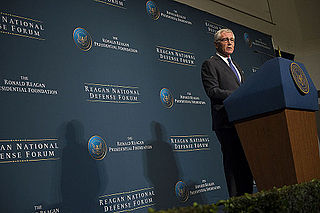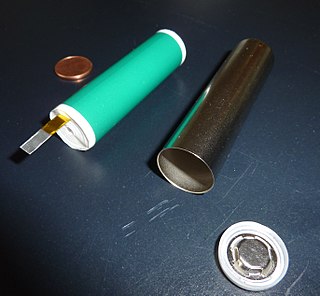Related Research Articles

Technology is the application of conceptual knowledge for achieving practical goals, especially in a reproducible way. The word technology can also mean the products resulting from such efforts, including both tangible tools such as utensils or machines, and intangible ones such as software. Technology plays a critical role in science, engineering, and everyday life.

Fusion power is a proposed form of power generation that would generate electricity by using heat from nuclear fusion reactions. In a fusion process, two lighter atomic nuclei combine to form a heavier nucleus, while releasing energy. Devices designed to harness this energy are known as fusion reactors. Research into fusion reactors began in the 1940s, but as of 2023, no device has reached net power.
Superpower describes a state or supranational union that holds a dominant position characterized by the ability to exert influence or project power on a global scale. This is done through the combined means of economic, military, technological, political, and cultural strength as well as diplomatic and soft power influence. Traditionally, superpowers are preeminent among the great powers. While a great power state is capable of exerting its influence globally, superpowers are states so influential that no significant action can be taken by the global community without first considering the positions of the superpowers on the issue.

A lithium-ion or Li-ion battery is a type of rechargeable battery that uses the reversible intercalation of Li+ ions into electronically conducting solids to store energy. In comparison with other rechargeable batteries, Li-ion batteries are characterized by higher specific energy, higher energy density, higher energy efficiency, a longer cycle life, and a longer calendar life. Also noteworthy is a dramatic improvement in lithium-ion battery properties after their market introduction in 1991: within the next 30 years, their volumetric energy density increased threefold while their cost dropped tenfold.
A superintelligence is a hypothetical agent that possesses intelligence far surpassing that of the brightest and most gifted human minds. "Superintelligence" may also refer to a property of problem-solving systems whether or not these high-level intellectual competencies are embodied in agents that act in the world. A superintelligence may or may not be created by an intelligence explosion and associated with a technological singularity.

Unrestricted Warfare: Two Air Force Senior Colonels on Scenarios for War and the Operational Art in an Era of Globalization is a book on military strategy written in 1999 by two colonels in the People's Liberation Army (PLA), Qiao Liang (乔良) and Wang Xiangsui (王湘穗). Its primary concern is how a nation such as China can defeat a technologically superior opponent through a variety of means. Rather than focusing on direct military confrontation, this book instead examines a variety of other means such as political warfare. Such means include using legal tools and economic means as leverage over one's opponent and circumvent the need for direct military action.

DEMO refers to a proposed class of nuclear fusion experimental reactors that are intended to demonstrate the net production of electric power from nuclear fusion. Most of the ITER partners have plans for their own DEMO-class reactors. With the possible exception of the EU and Japan, there are no plans for international collaboration as there was with ITER.
Intelligent Computer Assisted Language Learning (ICALL), or Intelligent Computer Assisted Language Instruction (ICALI), involves the application of computing technologies to the teaching and learning of second or foreign languages. ICALL combines Artificial intelligence with Computer Assisted Language Learning (CALL) systems to provide software that interacts intelligently with students, responding flexibly and dynamically to student's learning progress.
Artificial intelligence (AI) has been used in applications throughout industry and academia. AI, like electricity or computers, is a general-purpose technology that has a multitude of applications. It has been used in fields of language translation, image recognition, credit scoring, e-commerce and other domains.
The AI effect occurs when onlookers discount the behavior of an artificial intelligence program by arguing that it is not "real" intelligence.

Sodium-ion batteries (NIBs, SIBs, or Na-ion batteries) are several types of rechargeable batteries, which use sodium ions (Na+) as its charge carriers. In some cases, its working principle and cell construction are similar to those of lithium-ion battery (LIB) types, but it replaces lithium with sodium as the cathode material. Sodium belongs to the same group in the periodic table as lithium and thus has similar chemical properties. In other cases (such as aqueous Na-ion batteries) they are quite different from Li-ion batteries.

Autonomous Fusion, formerly WHEEGO Technologies, is an American company headquartered in Atlanta, Georgia. WHEEGO develops vehicle technologies including: software, systems, tools for self-driving cars or autonomous vehicles, artificial intelligence/machine learning, and IoT connected devices for the home, business and roadway. The company is led by CEO Mike McQuary.

An offset is some means of asymmetrically compensating for a disadvantage, particularly in a military competition. Rather than match an opponent in an unfavorable competition, changing the competition to more favorable footing enables the application of strengths to a problem that is otherwise either unwinnable or winnable only at unacceptable cost. An offset strategy consequently seeks to deliberately change an unattractive competition to one more advantageous for the implementer. In this way, an offset strategy is a type of competitive strategy that seeks to maintain advantage over potential adversaries over long periods of time while preserving peace where possible.
Product analysis involves examining product features, costs, availability, quality, appearance and other aspects. Product analysis is conducted by potential buyers, by product managers attempting to understand competitors and by third party reviewers.
A military artificial intelligence arms race is an arms race between two or more states to develop and deploy lethal autonomous weapons systems (LAWS). Since the mid-2010s, many analysts have noted the emergence of such an arms race between global superpowers for better military AI, driven by increasing geopolitical and military tensions. An AI arms race is sometimes placed in the context of an AI Cold War between the US and China.
The artificial intelligence (AI) industry in China is a rapidly developing multi-billion dollar industry. As of 2021, the artificial intelligence market is worth about RMB 150 billion, and is projected to reach RMB 400 billion by 2025. The roots of China's AI development started in the late 1970s following economic reforms emphasizing science and technology as the country's primary productive force.
Regulation of algorithms, or algorithmic regulation, is the creation of laws, rules and public sector policies for promotion and regulation of algorithms, particularly in artificial intelligence and machine learning. For the subset of AI algorithms, the term regulation of artificial intelligence is used. The regulatory and policy landscape for artificial intelligence (AI) is an emerging issue in jurisdictions globally, including in the European Union. Regulation of AI is considered necessary to both encourage AI and manage associated risks, but challenging. Another emerging topic is the regulation of blockchain algorithms and is mentioned along with regulation of AI algorithms. Many countries have enacted regulations of high frequency trades, which is shifting due to technological progress into the realm of AI algorithms.
The regulation of artificial intelligence is the development of public sector policies and laws for promoting and regulating artificial intelligence (AI); it is therefore related to the broader regulation of algorithms. The regulatory and policy landscape for AI is an emerging issue in jurisdictions globally, including in the European Union and in supra-national bodies like the IEEE, OECD and others. Since 2016, a wave of AI ethics guidelines have been published in order to maintain social control over the technology. Regulation is considered necessary to both encourage AI and manage associated risks. In addition to regulation, AI-deploying organizations need to play a central role in creating and deploying trustworthy AI in line with the principles of trustworthy AI, and take accountability to mitigate the risks. Regulation of AI through mechanisms such as review boards can also be seen as social means to approach the AI control problem.
Military-civil fusion or civil-military fusion is a strategy and policy of the Chinese Communist Party (CCP) with the stated goal of developing its People's Liberation Army (PLA) into a world-class military. Military-civil fusion is a priority for the Xi Jinping administration.

Lithium batteries are primary batteries that use lithium as an anode. This type of battery is also referred to as a lithium-ion battery and is most commonly used for electric vehicles and electronics. The first type of lithium battery was created by the British chemist M. Stanley Whittingham in the early 1970s and used titanium and lithium as the electrodes. Unfortunately, applications for this battery were limited by the high prices of titanium and the unpleasant scent that the reaction produced. Today's lithium ion battery, modeled after the Whittingham attempt by Akira Yoshino, was first developed in 1985.
References
- ↑ Moldicz, Csaba (July 7, 2021). China, the USA and Technological Supremacy in Europe. London: Routledge. doi:10.4324/9781003128625. ISBN 978-1-003-12862-5. S2CID 242607596.
- ↑ Inkster, Nigel (2021). The Great Decoupling China, America and the Struggle for Technological Supremacy. Hurst Publishers. ISBN 978-1-78738-613-6. OCLC 1259590704.
- 1 2 Eaglen, Mackenzie (2012). US military technological supremacy under threat. American Enterprise Institute. OCLC 820674427.
- 1 2 Cecil, Andrew Rockover (September 1, 1957). "The soviet challenge for technological supremacy". Peabody Journal of Education. 35 (2): 67–76. doi:10.1080/01619565709536774. ISSN 0161-956X.
- ↑ Paine, Lincoln P. (2000). Ships of discovery and exploration. Boston: Houghton Mifflin Co. pp. 142–143. ISBN 0-395-98415-7. OCLC 44128252.
- ↑ Gewirtz, Julian (June 23, 2021). "China's Long March to Technological Supremacy". Foreign Affairs. ISSN 0015-7120 . Retrieved August 18, 2022.
- ↑ "China and the United States: The Battle for Technological Supremacy". nippon.com. July 30, 2019. Retrieved August 18, 2022.
- ↑ Han, The Anh; Moniz Pereira, Luis; Santos, Francisco C.; Lenaerts, Tom (November 22, 2020). "To Regulate or Not: A Social Dynamics Analysis of an Idealised AI Race". Journal of Artificial Intelligence Research. 69: 881–921. doi: 10.1613/jair.1.12225 . hdl: 10362/121438 . ISSN 1076-9757. S2CID 227183091.
- ↑ Amanullah, Q.; Khan, M.K. (2020). The G-War: Race for technological supremacy in 5G and 6G. Global Foundation for Cyber Studies and Research.
- ↑ Kim, Hojong; Boysen, Dane A.; Newhouse, Jocelyn M.; Spatocco, Brian L.; Chung, Brice; Burke, Paul J.; Bradwell, David J.; Jiang, Kai; Tomaszowska, Alina A.; Wang, Kangli; Wei, Weifeng; Ortiz, Luis A.; Barriga, Salvador A.; Poizeau, Sophie M.; Sadoway, Donald R. (March 13, 2013). "Liquid Metal Batteries: Past, Present, and Future". Chemical Reviews. 113 (3): 2075–2099. doi:10.1021/cr300205k. ISSN 0009-2665. PMID 23186356.
- ↑ "Bolivia: A World Power in Lithium, the Coup d'état and the Dispute for Technological Supremacy Between the USA and China". Journal of Applied Business and Economics. 22 (3). July 29, 2020. doi: 10.33423/jabe.v22i3.2855 . ISSN 1499-691X. S2CID 241530448.
- ↑ "China's Vast Blueprint for Tech Supremacy Over U.S." Bloomberg.com. January 23, 2022. Retrieved August 18, 2022.
- ↑ Sutton, Jeanne C. Marrying commercial and military technologies : strategy for maintaining technological supremacy.. (1993). Essays on strategy (PDF). National Defense University Press. OCLC 1023497246.
- ↑ "To maintain tech supremacy the US must avoid 'military-civil fusion'". Financial Times. March 11, 2021. Retrieved August 18, 2022.
- ↑ Stanford, Claire (2022). "Ready Player One and the Reassertion of US Economic and Technological Supremacy". MFS Modern Fiction Studies. 68 (2): 201–218. doi:10.1353/mfs.2022.0009. ISSN 1080-658X. S2CID 250080460.